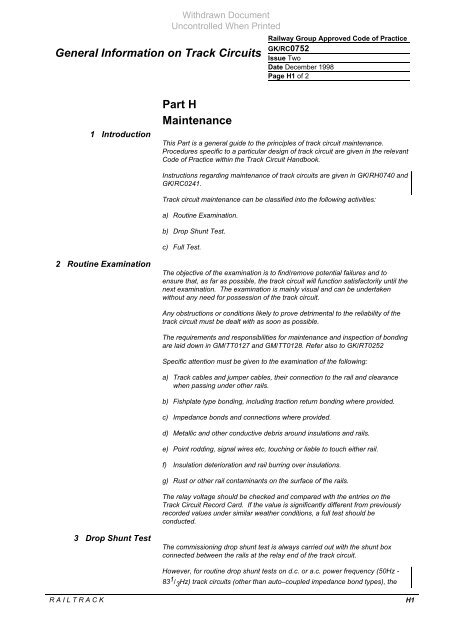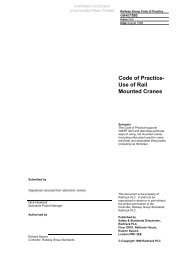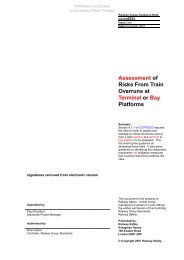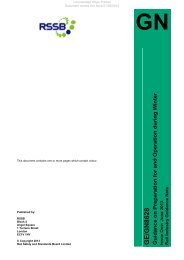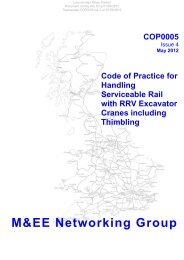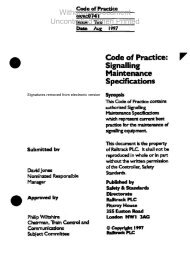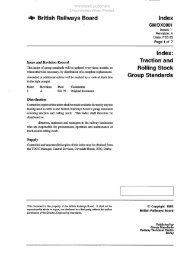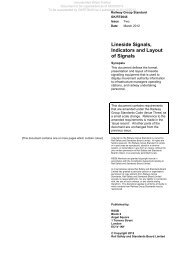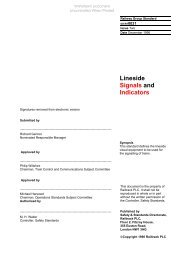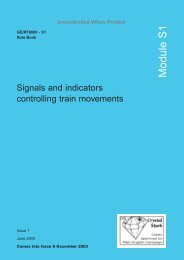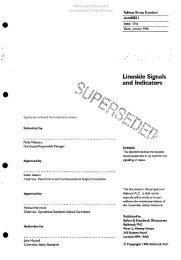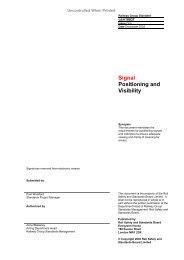General Information on Track Circuits - RGS Online
General Information on Track Circuits - RGS Online
General Information on Track Circuits - RGS Online
Create successful ePaper yourself
Turn your PDF publications into a flip-book with our unique Google optimized e-Paper software.
<str<strong>on</strong>g>General</str<strong>on</strong>g> <str<strong>on</strong>g>Informati<strong>on</strong></str<strong>on</strong>g> <strong>on</strong> <strong>Track</strong> <strong>Circuits</strong><br />
1 Introducti<strong>on</strong><br />
2 Routine Examinati<strong>on</strong><br />
3 Drop Shunt Test<br />
Withdrawn Document<br />
Unc<strong>on</strong>trolled When Printed<br />
Part H<br />
Maintenance<br />
Railway Group Approved Code of Practice<br />
GK/RC0752<br />
Issue Two<br />
Date December 1998<br />
Page H1 of 2<br />
This Part is a general guide to the principles of track circuit maintenance.<br />
Procedures specific to a particular design of track circuit are given in the relevant<br />
Code of Practice within the <strong>Track</strong> Circuit Handbook.<br />
Instructi<strong>on</strong>s regarding maintenance of track circuits are given in GK/RH0740 and<br />
GK/RC0241.<br />
<strong>Track</strong> circuit maintenance can be classified into the following activities:<br />
a) Routine Examinati<strong>on</strong>.<br />
b) Drop Shunt Test.<br />
c) Full Test.<br />
The objective of the examinati<strong>on</strong> is to find/remove potential failures and to<br />
ensure that, as far as possible, the track circuit will functi<strong>on</strong> satisfactorily until the<br />
next examinati<strong>on</strong>. The examinati<strong>on</strong> is mainly visual and can be undertaken<br />
without any need for possessi<strong>on</strong> of the track circuit.<br />
Any obstructi<strong>on</strong>s or c<strong>on</strong>diti<strong>on</strong>s likely to prove detrimental to the reliability of the<br />
track circuit must be dealt with as so<strong>on</strong> as possible.<br />
The requirements and resp<strong>on</strong>sibilities for maintenance and inspecti<strong>on</strong> of b<strong>on</strong>ding<br />
are laid down in GM/TT0127 and GM/TT0128. Refer also to GK/RT0252<br />
Specific attenti<strong>on</strong> must be given to the examinati<strong>on</strong> of the following:<br />
a) <strong>Track</strong> cables and jumper cables, their c<strong>on</strong>necti<strong>on</strong> to the rail and clearance<br />
when passing under other rails.<br />
b) Fishplate type b<strong>on</strong>ding, including tracti<strong>on</strong> return b<strong>on</strong>ding where provided.<br />
c) Impedance b<strong>on</strong>ds and c<strong>on</strong>necti<strong>on</strong>s where provided.<br />
d) Metallic and other c<strong>on</strong>ductive debris around insulati<strong>on</strong>s and rails.<br />
e) Point rodding, signal wires etc, touching or liable to touch either rail.<br />
f) Insulati<strong>on</strong> deteriorati<strong>on</strong> and rail burring over insulati<strong>on</strong>s.<br />
g) Rust or other rail c<strong>on</strong>taminants <strong>on</strong> the surface of the rails.<br />
The relay voltage should be checked and compared with the entries <strong>on</strong> the<br />
<strong>Track</strong> Circuit Record Card. If the value is significantly different from previously<br />
recorded values under similar weather c<strong>on</strong>diti<strong>on</strong>s, a full test should be<br />
c<strong>on</strong>ducted.<br />
The commissi<strong>on</strong>ing drop shunt test is always carried out with the shunt box<br />
c<strong>on</strong>nected between the rails at the relay end of the track circuit.<br />
However, for routine drop shunt tests <strong>on</strong> d.c. or a.c. power frequency (50Hz -<br />
831 / 3Hz) track circuits (other than auto–coupled impedance b<strong>on</strong>d types), the<br />
R A I L T R A C K H1


